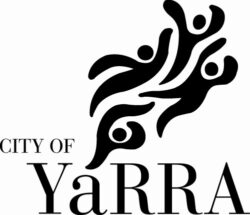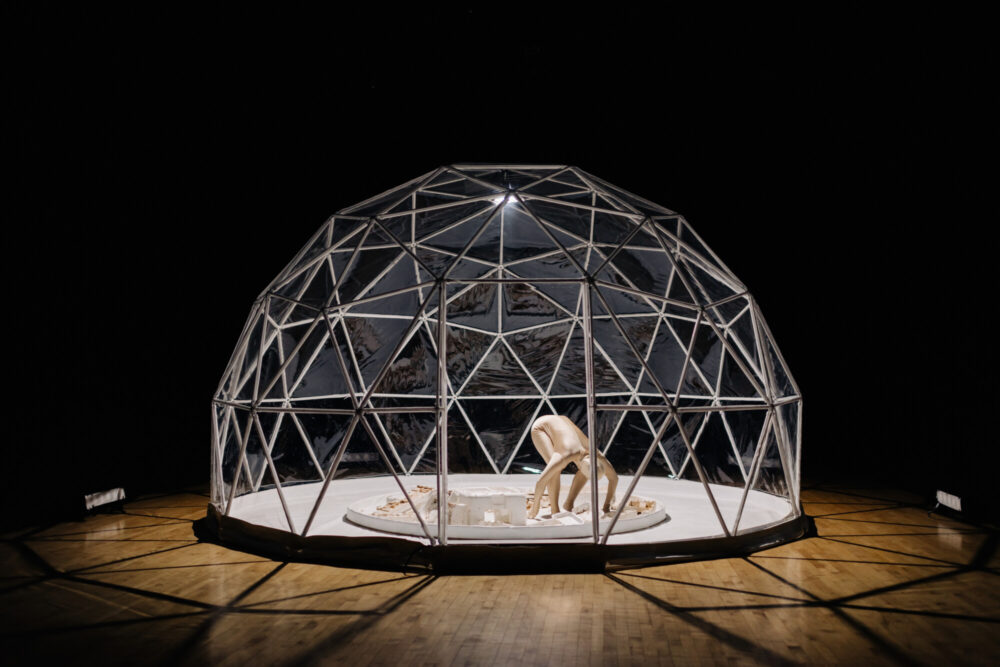MASS—bloom explorations
Recoil Performance Group



— A tiny co-species-farm devours a plastic landscape
Hilde Sandvold lives alongside thousands of live mealworms in a transparent dome littered with Styrofoam.
Together, their tiny farm slowly but visibly consumes the plastic world around them. The crunching sound of the eating mealworms blends with the voice of author Ida Marie Hede.
This three-day durational choreographic performance creates a new form of symbiosis. The potential of co-evolution — the blooming of a new species born from a plastic habitat.
From throwaway litter, waste, decay, decomposition, death is the possibility of regeneration and rebirth.
“When I and my species have eventually gone from this earth, my worm-eaten furniture will be left like haunted sculptures in damp, slimy, lush or barren landscapes. Future creatures will crawl on the archaeological objects. In the future I will either be extinct, everything buzzing along, or I will have done an evolutionary quantum leap in order to adapt to the dying planet, I will have sacrificed a plethora of species as I overtake them; lost peacocks, zebras and storks.” – Ida Marie Hede
Recoil Performance Group is a Copenhagen-based performance group, founded in 2005 by choreographer Tina Tarpgaard. The group works with choreography and performances that cut across established aesthetic categories. Kinaesthetic interaction with the scenographic elements in which the choreography it set, has been a consistent focus of Tarpgaard’s work. In her early performances, this took the form of digital trompe-l’oeil projections, while later efforts have focused more sensorial, analogue universes where light and sound becomes concrete elements in motion.
Choreographer: Tina Tarpgaard
Performer: Hilde I. Sandvold
Science-art researcher and installation design: Pei-Ying Lin
Author: Ida Marie Hede
Technical and engineering design: Minshu Huang
Sound design: Søren Knud
Dramaturge: Inge Agnete Tarpgaard
Production managers: Rasmus Sylvest, Viktor K. Magnusson
Producer: Carlos Calvo
Supported by The City of Yarra
MASS-bloom explorations invite the audience to come close to the perishability, decomposing and death that all living beings on the earth are confronted with and eventually become part of. A single human dancer and thousands of mealworms inhabit a transparent plastic dome. In this unlikely (bio) logical combination of greenhouse and mausoleum, we are reminded of the basic circumstances of life; to sleep, eat, defecate and multiply; the living and the dead, the urge and the will. The relationship between what perishes and what remains is central to the speculative nature of the work – the visions of a future of extensive man-made environmental change. The work reconsiders a culture of consumption and superior self-esteem, which are some of the less flattering characteristics of humanity.
“With the authority of the natural sciences in the back and on the basis of clear indications that humans is responsible for the climate change we experience, a few years ago a new geological epoch was named after ourselves: the Anthropocene Age. The MASS-bloom explorations work began as a curiosity about the extreme in this timeframe – an early stage in which the rise of human beings and potential eradication is a glimpse in a much larger whole. It has led to a work where many time scales occur in parallel in both movement and text.
The implicit underlining of a self-inflicted self-extinction by the name of the epoch also nourished the need to relate to concepts such as mass extinction, to decay and to our common mortality. For that reason, the mealworm became my co-worker in the process. A creature that provokes both disgust and fascination, and at the same time made new temporalities applicable to my choreographic work. Specifically, the mealworm’s molding process of foamplastic creates the overall timeframe of the installation being several days. At the same time, the daily time-long performance manifest itself clearly in the movements of the dancer” – Tina Tarpgaard
The sound of worms consuming plastic constitutes the soundscape of the installation along with a text written and read by author Ida Marie Hede.
“MASS-bloom was based on the relationship between human and non-human, human mortality, demise and death, not as a doomsday scenario, but as an exploration of transformative processes that inevitably lead to something new to occur. In my novel Bedårende (Adore) I was really interested in continuities and relationships between death and life, the fabulatory and the concrete, the speculative or spiritual and the material. In not letting fear disassemble and polarize elements that naturally hangs together. I think that MASS as a project has the same ambition: In the installation there is physical work and the experiment of letting a human being, as a biological body, meet all these mealworms that can break down a version of plastic, and staging feces, deaths, everyday life and physicality in a kind of coexistence between human and melorm.” – Ida Marie Hede
The text of MASS-bloom explorations has been created specifically for the installation, but with clear reference to the very special and refined linguistic examination of the relationship between the material and the immaterial, the living and the dead, the disappearing and the remaining. At the same time an artistic interplay between the text and the bodies, space and words occurs, which, as tectonic plates, make the speculative layers of the work affect each other.
“Because MASS-bloom is so much about engaging in new materialities, it made sense to have another kind of materiality, a language that can complicate what we just saw. And also, a whole different speed! The performer moves slowly, the text moves quickly through several rooms. It was also important to give a sense of a non-problematic, but after all affectionate coexistence between the I and the mealworms, to make the inaccurate, material, fragile life with food residue, hair, nails, chicken legs, etc. to be prominent. A constant question of the presence of mealworms, but also a surrender to a life on their terms. And then I had a lot of fun writing some kind of “The Fly”-like (Cronenberg’s film from 1986) fusion of human-I and mealworm in the end of the text, to go all the way with coexistence.” – Ida Marie Hede
One (hu)man’s garbage – the other worm’s food
That mealworms can eat and digest plastic is a relatively new discovery that has gained attention from science, environmental activists and, in this case, artists. Here can be found, if not the germ to, there the hope of doing something active about our contamination of the planet. The little heroes who occupy the installation may also have a role to play in a larger environmental context. At the same time, many humans connect worms with perishability, wrath and decay. Ultimately, we face our own mortality when we behold their energetic consumption of material. It is ultimately insects and worms that will also translate our physical body and allow us to become part of the mold of the globe. In MASS-bloom explorations, it is the white Styrofoam that the worms munches on. A well-known residual product from our electrical appliances, donated to the installation of shops and private individuals. At the same time, the installation’s leading scenographic element, and the primary nutritional source of the worms.
Biodesign and mathematical beauty
With MASS-bloom, recoil collaborated with the award-winning bio designer and artist Pei-Ying Lin, who designed the dome, which is the focal point of the installation and dancer and the common habitat for the mealworms.
“The dome idea started with building up an enclosed experimental field that is an ecosystem in itself, which lead me to start looking for ways to ‘envelop’ a self-standing, isolated environment. The thought if of finding a right envelop reminded me of the icosahedral symmetry that viruses use – with minimal types and numbers of proteins to construct an enclosed protein envelop (a viral shell). Whereas the same geometric symmetry in the human world would be the geodesic dome – a structure that’s been invented by Walther Bauersfeld after World War I for a planetarium and which later being named ‘geodesic’ by architect Buckminster Fuller with artist Kenneth Snelson during field experiments on providing more economical shelters for people. The geodesic dome design is also very often being used for greenhouses or planetariums nowadays, one example being Montreal Biosphere at expo 67.” – Pei-Ying Lin
Future bodies and others forms of life
In MASS-bloom explorations we let the installation of worms and human beings point towards the possibility of co-existence in new ways, with creatures completely different to ourselves. Biological alliances across life forms are nothing new. For many species, mutual dependence is an essential part of their survival strategy. The hypothetical alliance between human and a worm that can break down our left-over plastic is probably not the answer to the environmental challenges we face. But it is an artistic suggestion of how humanity as nature and culture must be willing to accept change in our relation to the fragile ecosystem we form together with the rest of the planet’s organisms.

Collaborators: Ottawa Dance Directive, Windsor University, Westboro Village
Supported by: The Danish Arts Foundation, Wilhem Hansen Foundation, The Augustinus Foundation, Louis Hansen Foundation, Københavns Kommunes Scenekunstudvalg


